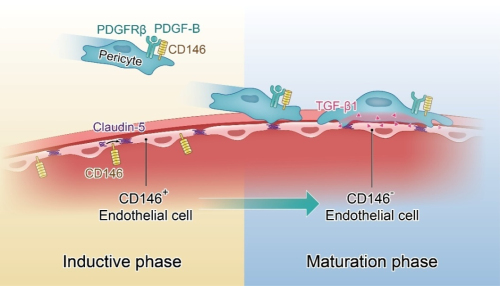CD146 Coordinates Blood–brain Barrier Development
The blood-brain barrier (BBB) establishes a physical barrier essential for homeostasis of the central nervous system (CNS). Development of BBB during embryogenesis is a gradual process that starts when brain endothelial cells (BECs) invade the CNS and express tight junction (TJ) proteins, establishing a high-resistance paracellular barrier to ions and molecules. Later, barrier properties of the BBB mature as pericytes are recruited to nascent vessels and improve the barrier function by elaborating TJs, decreasing transcytosis and regulating CNS immune surveillance. Despite the importance of intimate cross-talk between BECs and pericytes in the regulation of BBB development, the molecular regulation of BEC-pericyte communication during this progressive process remains incompletely understood.
Professor YAN Xiyun of the Institute of Biophysics of the Chinese Academy of Sciences, in cooperation with Professor ZHANG Jingjing of the Affiliated Hospital of Guangdong Medical University, demonstrates that a single cell adhesion receptor, CD146, could spatiotemporally coordinate the BEC-pericyte communication and contribute to the functional formation of BBB during embryogenesis.
Their research shows that the expression of CD146 is dynamic during BBB development, where CD146 is first expressed in BECs of nascent vessels; following pericyte recruitment, CD146 is exclusively expressed in the pericytes but not in BECs covered with pericytes. By analyzing the regulatory mechanisms of CD146 in this process, they report that the dynamic expression of CD146 in ECs and pericytes could regulate progressive functional formation at different stages of BBB development. The work shows that early in embryonic development, endothelial CD146 promotes barrier induction by regulating the expression of claudin-5, a critical member of TJ proteins. Subsequently, pericyte-expressed CD146 controls pericyte recruitment to BECs. Accompanied with the pericyte recruitment, endothelial CD146 is finally downregulated by pericyte-secreted TGF-β1, contributing to further BBB maturation.
The work not only makes a significant progress in understanding of molecular regulation of BBB development, but also links the low CD146 expression in BECs of the mature BBB to a quiescent CNS immune state. Combined with previous studies from YAN’s lab and others’ showing that CD146 is significantly elevated in BECs to promote neuroinflammation in multiple sclerosis, their work demonstrates that CD146 could be a key regulator to CNS immune surveillance, and a potential therapeutic target for treating neuroinflammatory diseases associated with BBB breakdown.

Figure: CD146 coordinates brain endothelial cell-pericyte communication during the development of blood-brain barrier.(Image by IBP)
This research article entitled CD146 coordinates brain endothelial cell-pericyte communication for blood–brain barrier development online in the journal PNAS on August 21, 2017, was supported by the Ministry of Science and Technology 973 Project, the National Science Foundation, the Strategic Priority Research Program of the Chinese Academy of Sciences and the National Science Foundation of Guangdong Province.
Contact:
YAN Xiyun
Institute of Biophysics
E-mail: yanxy@ibp.ac.cn

